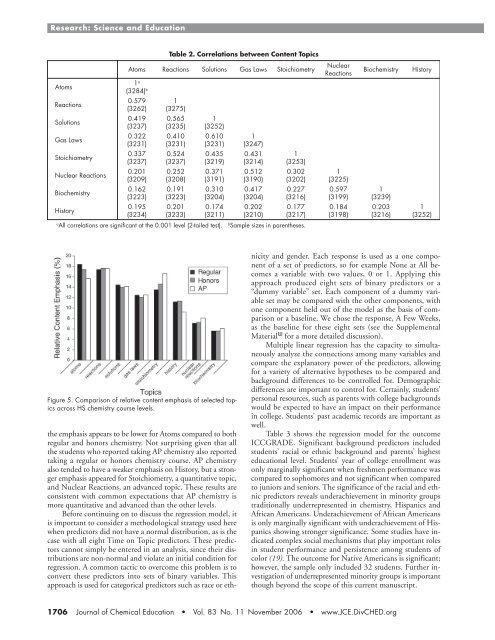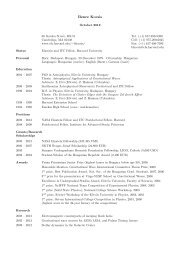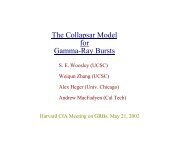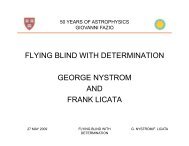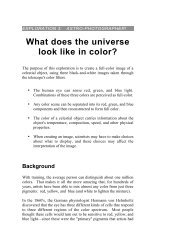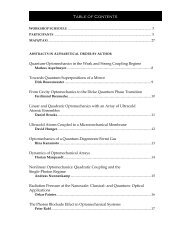High School Chemistry Content Background of Introductory College ...
High School Chemistry Content Background of Introductory College ...
High School Chemistry Content Background of Introductory College ...
Create successful ePaper yourself
Turn your PDF publications into a flip-book with our unique Google optimized e-Paper software.
Research: Science and Education<br />
Table 2. Correlations between <strong>Content</strong> Topics<br />
Atoms<br />
Reactions<br />
Solutions<br />
Gas<br />
Laws<br />
Stoichiometry<br />
Nuclear<br />
Reactions<br />
Biochemistry<br />
History<br />
Atoms<br />
Reactions<br />
Solutions<br />
Gas Laws<br />
Stoichiometry<br />
Nuclear Reactions<br />
Biochemistry<br />
History<br />
1 a b<br />
( 3284)<br />
0.579<br />
(3262)<br />
0.419<br />
(3237)<br />
0.322<br />
(3231)<br />
0.337<br />
(3237)<br />
0.201<br />
(3209)<br />
0.162<br />
(3223)<br />
0.195<br />
(3234)<br />
1<br />
(3275)<br />
0.565<br />
(3235)<br />
0.410<br />
(3231)<br />
0.524<br />
(3237)<br />
0.252<br />
(3208)<br />
0.191<br />
(3223)<br />
0.201<br />
(3233)<br />
1<br />
(3252)<br />
0.610<br />
(3231)<br />
0.435<br />
(3219)<br />
0.371<br />
(3191)<br />
0.310<br />
(3204)<br />
0.174<br />
(3211)<br />
1<br />
(3247)<br />
0.431<br />
(3214)<br />
0.512<br />
(3190)<br />
0.417<br />
(3204)<br />
0.202<br />
(3210)<br />
1<br />
(3253)<br />
0.302<br />
(3202)<br />
0.227<br />
(3216)<br />
0.177<br />
(3217)<br />
1<br />
(3225)<br />
0.597<br />
(3199)<br />
0.184<br />
(3198)<br />
1<br />
(3239)<br />
0.203<br />
(3216)<br />
1<br />
(3252)<br />
a<br />
ll correlations are significant at the 0.001 level (2-tailed test) .<br />
b<br />
A Sample sizes in parentheses.<br />
Figure 5. Comparison <strong>of</strong> relative content emphasis <strong>of</strong> selected topics<br />
across HS chemistry course levels.<br />
the emphasis appears to be lower for Atoms compared to both<br />
regular and honors chemistry. Not surprising given that all<br />
the students who reported taking AP chemistry also reported<br />
taking a regular or honors chemistry course. AP chemistry<br />
also tended to have a weaker emphasis on History, but a stronger<br />
emphasis appeared for Stoichiometry, a quantitative topic,<br />
and Nuclear Reactions, an advanced topic. These results are<br />
consistent with common expectations that AP chemistry is<br />
more quantitative and advanced than the other levels.<br />
Before continuing on to discuss the regression model, it<br />
is important to consider a methodological strategy used here<br />
when predictors did not have a normal distribution, as is the<br />
case with all eight Time on Topic predictors. These predictors<br />
cannot simply be entered in an analysis, since their distributions<br />
are non-normal and violate an initial condition for<br />
regression. A common tactic to overcome this problem is to<br />
convert these predictors into sets <strong>of</strong> binary variables. This<br />
approach is used for categorical predictors such as race or ethnicity<br />
and gender. Each response is used as a one component<br />
<strong>of</strong> a set <strong>of</strong> predictors, so for example None at All becomes<br />
a variable with two values, 0 or 1. Applying this<br />
approach produced eight sets <strong>of</strong> binary predictors or a<br />
“dummy variable” set. Each component <strong>of</strong> a dummy variable<br />
set may be compared with the other components, with<br />
one component held out <strong>of</strong> the model as the basis <strong>of</strong> comparison<br />
or a baseline. We chose the response, A Few Weeks,<br />
as the baseline for these eight sets (see the Supplemental<br />
Material W for a more detailed discussion).<br />
Multiple linear regression has the capacity to simultaneously<br />
analyze the connections among many variables and<br />
compare the explanatory power <strong>of</strong> the predictors, allowing<br />
for a variety <strong>of</strong> alternative hypotheses to be compared and<br />
background differences to be controlled for. Demographic<br />
differences are important to control for. Certainly, students’<br />
personal resources, such as parents with college backgrounds<br />
would be expected to have an impact on their performance<br />
in college. Students’ past academic records are important as<br />
well.<br />
Table 3 shows the regression model for the outcome<br />
ICCGRADE. Significant background predictors included<br />
students’ racial or ethnic background and parents’ highest<br />
educational level. Students’ year <strong>of</strong> college enrollment was<br />
only marginally significant when freshmen performance was<br />
compared to sophomores and not significant when compared<br />
to juniors and seniors. The significance <strong>of</strong> the racial and ethnic<br />
predictors reveals underachievement in minority groups<br />
traditionally underrepresented in chemistry, Hispanics and<br />
African Americans. Underachievement <strong>of</strong> African Americans<br />
is only marginally significant with underachievement <strong>of</strong> Hispanics<br />
showing stronger significance. Some studies have indicated<br />
complex social mechanisms that play important roles<br />
in student performance and persistence among students <strong>of</strong><br />
color (19). The outcome for Native Americans is significant;<br />
however, the sample only included 32 students. Further investigation<br />
<strong>of</strong> underrepresented minority groups is important<br />
though beyond the scope <strong>of</strong> this current manuscript.<br />
1706 Journal <strong>of</strong> Chemical Education • Vol. 83 No. 11 November 2006 • www.JCE.DivCHED.org


